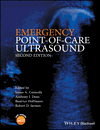Doppler Assessment of Haemodynamics
Summary
This chapter focuses on qualitative (colour) Doppler, quantitative Doppler, Doppler measurement of flow volumes, pulsatile flow measurements, continuous-wave Doppler, pulsed-wave Doppler, quantifying haemodynamics, potential energy to kinetic energy ratio (PKR) and left ventricular end-diastolic volume (LVEDV). The ultrasound machine can be arranged so that flows towards the probe (positive Doppler shift) can be shown in one colour, while flows away from the probe (negative Doppler shift) are shown in a different colour. While colour Doppler can give an immediate impression of flow direction and velocity, Doppler can also be used to measure the actual velocity of flow and even the pressures involved. Pulsatile flow is a little more tricky, since what is needed is the mean flow velocity. In continuous-wave Doppler, a transmitting crystal sends out a continuous beam of ultrasound while a receiving crystal 'listens' to the echoes coming back.



